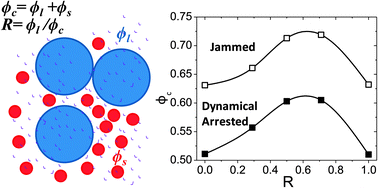We explore the rheology of high density glasses formed by binary colloidal mixtures in unentangled polyethylene glycol melts with a molecular weight of 400. A particle size ratio δ = dl/ds = 4.8 is chosen to ensure that mixing results in a reduction in composite rheology without phase separation for a fixed high total volume fraction, ϕc. We explore frequency dependent linear viscoelastic behaviors, yielding and shear-thickening behaviors, and study properties as a function of the volume fraction ratio of the large particles, R. We characterize the cross-over volume fractions which denote the onset of transient particle localization, ϕx, and the maximum packing fractions, ϕm, and find that both are non-monotonic functions of R, with ϕm/ϕx being a constant as R is varied from 0 to 1. Hard sphere scaling fails to capture the effects of particle size when R = 0 and R = 1, demonstrating that, even for these low molecular weight oligomers, polymer absorption and alterations of polymer configurations modify pair potentials away from being solely volume exclusion in nature. Changes in linear rheology, yielding behavior and shear-thickening are discussed in terms of a pseudo one-component model that depends on the dimensionless volume fraction ϕ* = (ϕm − ϕx)/(ϕm − ϕc).

You have access to this article
 Please wait while we load your content...
Something went wrong. Try again?
Please wait while we load your content...
Something went wrong. Try again?


 Please wait while we load your content...
Please wait while we load your content...